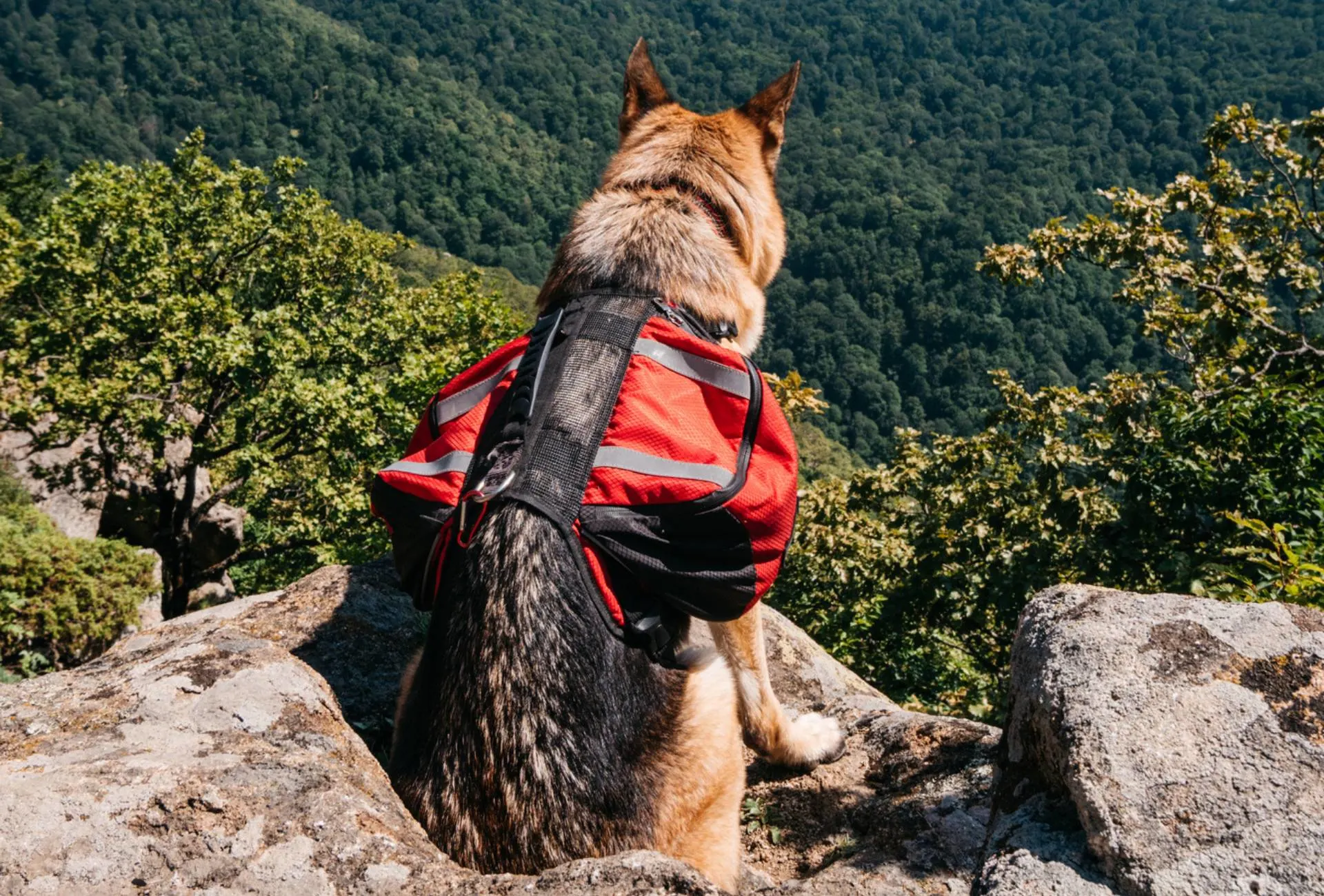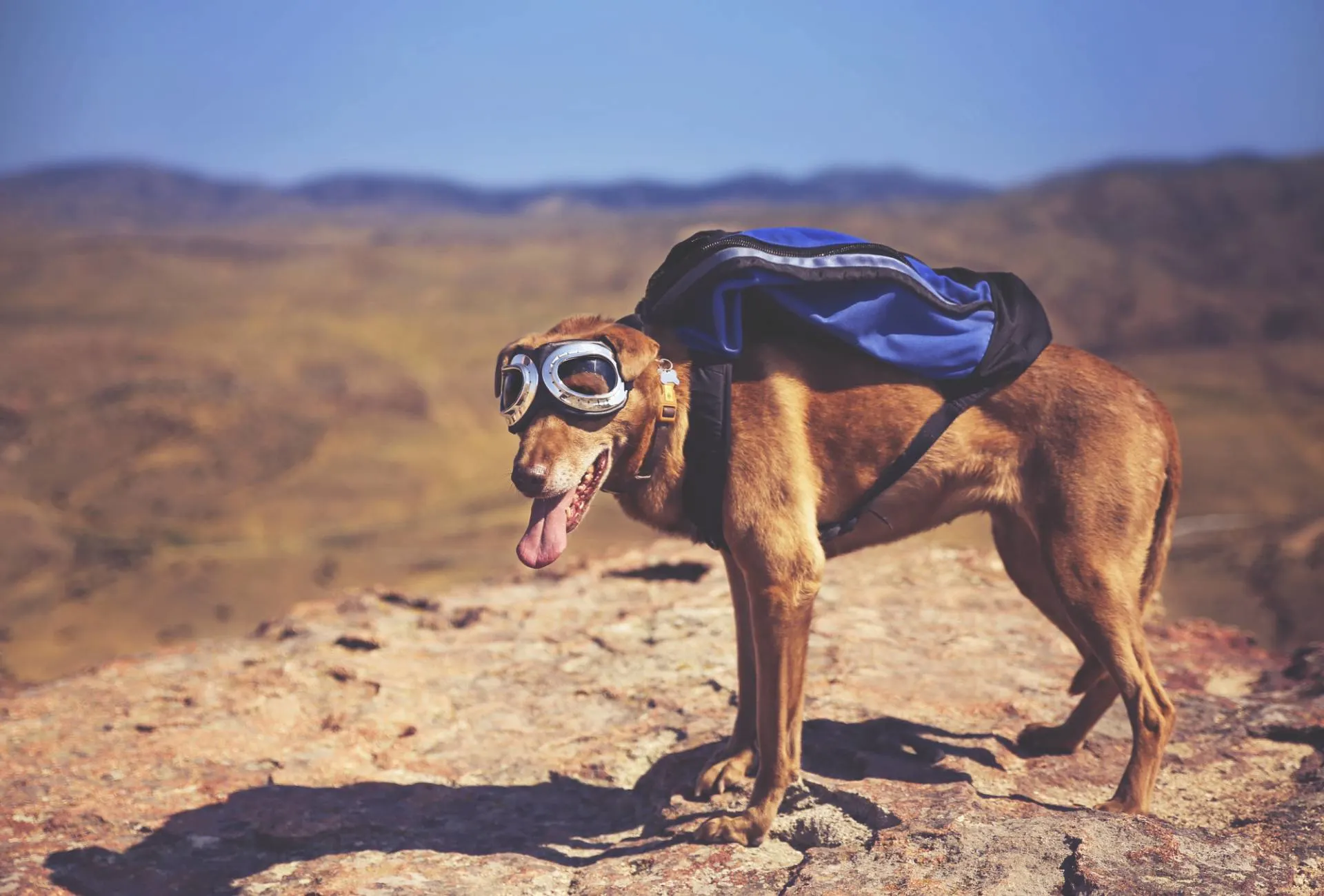Whether you go for a one-day hike or a multi-day camping trip, you might wonder if your dog can pull their weight.
Hiking with your pooch is a fun activity but it sure would be nice to share the load with your furry companion.
In this article, we’ll explore how much weight a dog can actually carry but also whether or not it makes sense for every dog (spoiler: it doesn’t).
Not every dog of every breed, age, and health status should carry a pack, I’ll dive deeper into that below.
Before you plan any trip with your pack-carrying canine, make sure your dog is used to the feeling of the pouches and the final load.
We don’t want any surprises on the trail.
Here’s a little checklist of what to keep in mind when slinging that backpack onto your dog.
- Your dog is fit and able to carry their pack
- Dog’s backpack fits well
- Weight is distributed evenly
- Dog will carry something that’s actually useful or has fun doing it
- Emergency plan in place (e.g. rescue sling)
Let’s dive into how much weight your dog is able to carry.
How Much Weight Can a Dog Carry?
Beginner adult dogs can start carrying 10% of their body weight and gradually increase to a max of 20-25%. Seniors, puppies, and sick dogs should not carry any significant load.
The absolute max is 25% for certain breeds as healthy adults ideally between 2 and 6 years of age and with training.

Sure, some dogs might be able to carry a tad more but in my opinion, the risks are just not worth it.
Consider yourself and how much you can carry.
Outdoor gear giant REI recommends up to 20% of your body weight for a loaded backpacking pack, and 10% for a day hiking pack.
A fit 150-pound hiker certainly won’t be in a rush to scale any mountains with 30 pounds of gear.
As per NPR, there might be Sherpas who best Mt. Everest carrying “nearly 90 percent of their body weight”.
But that article also mentions that a physically fit American will get tired with 20-25% of their body weight after a day or two trekking.
So don’t go out there and assume your pup has super-canine strength. Small or medium-sized dogs just can’t carry much.
Consider this: The Deuter Futura 32L pack I have weighs 1440 g (3.2 lbs) on its own. So a 15 kg (roughly 33 lbs) dog would already be at 10% of their body weight with this human pack alone.
To make it simple, I’ve created this little chart so you know exactly how much your dog can carry, depending on their body weight and experience.
| Dog weight | 10% (beginner) | 15% | 25% (expert) |
|---|---|---|---|
| 10 lbs | 1 lb | 1.5 | 2.5 |
| 20 lbs | 2 lbs | 3 | 5 |
| 30 lbs | 3 lbs | 4.5 | 7.5 |
| 40 lbs | 4 lbs | 6 | 10 |
| 50 lbs | 5 lbs | 7.5 | 12.5 |
| 60 lbs | 6 lbs | 9 | 15 |
| 70 lbs | 7 lbs | 10.5 | 17.5 |
| 80 lbs | 8 lbs | 12 | 20 |
| 90 lbs | 9 lbs | 13.5 | 22.5 |
| 100 lbs | 10 lbs | 15 | 25 |
| 120 lbs | 12 lbs | 18 | 30 |
| 140 lbs | 14 lbs | 21 | 35 |
Tip: consider the weight of the dog harness and pouches, especially if you have a small dog.
Depending on the size, I’ve found sturdy dog harnesses with pouches weighing 790 g – 1351 g (1.74 lbs – 2.97 lbs).
Lighter harnesses such as the one Ruffwear makes still weigh roughly 360 g – 590 g (0.8 lbs – 1.3 lbs), depending on the model.
Apart from that, you need to make sure that the backpack fits well.

Make sure that the belly straps don’t limit shoulder movement and that the chest strap lies above the shoulders.
The pouches your dog will carry should not hang too long or be fitted too tight and the weight should be distributed evenly between the two sides.
Ask yourself if your dog will actually have fun carrying that pack.
Some breeds are built for this, others just aren’t.
Whether you want to do this simply to split the load or to provide your canine with a job, it should always be fun and not too strenuous for your dog.
Last but not least, have a backup plan if your dog gets injured and isn’t able to carry the pack anymore.
Can you shoulder the pack as well as your dog in a rescue sling if push comes to shove?
Lastly, introduce hiking with the pack!
To make sure your dog will accept the hiking pack, follow these steps:
- Go hiking for 2-3 hours without a pack for a couple of weeks
- Gradually introduce the pack at home without any load, reward
- Bring the empty pack on a short trip
- Plan a couple of trips with a slightly loaded pack
Small Dogs
Small dogs will be significantly more impacted by the unloaded pouches and might not have as much fun as breeds bred trained for similar purposes.
Whereas a 100-pound canine weighs 5x as much as a 20-pound dog, their empty backpack only weighs twice as much.
And small dogs are usually not bred to pull weight in any way shape or form.
Many small breeds are simply bred as companions (lovingly called lapwarmer or handwarmer back in the day).
Even if small breeds got a job done, it usually involved hunting, scent- and sighthounds, or specifically rat catching.
Small dogs are just not made to carry a significant load and thus won’t benefit you much when camping in terms of load-sharing.
That doesn’t mean your own small dog won’t benefit from a job to do.
If your dog is fit, will have fun, and you can cope with the fact that their group contribution will remain measly, you can still opt to give them something to carry.
Just make sure to discuss any issues with your vet before loading up your small pooch.
Puppies and Seniors
Puppies and seniors are usually advised to carry no more than 10% of their body weight but personally, I’d recommend not to let a puppy or senior carry any additional weight.
Puppies are growing and certain exercises should be postponed or limited until bone growth has finished at around 18 months depending on the breed.
These exercise limitations include jogging, frequent chasing after toys such as a flirt pole, or other high-impact exercises.
So it’s only natural not to pack your little pup with extra weight.
Besides, puppies need socialization and exploration much more than they could gain from carrying stuff.
Healthy seniors used to carrying weight might still be able to do so.
I’d personally just let my dog have fun enjoying their golden years but if you think your dog enjoys it, talk to your vet to be safe.
10 Best Dog Breeds For Carrying Weight
Dog breeds suitable for carrying weight include the following:
- Rottweiler
- Greater Swiss Mountain Dog
- Bernese Mountain Dog
- Saint Bernard
- Cane Corso
- Boxer
- Bullmastiff
- Dogo Argentino
- Doberman
- Great Dane
Keep in mind that your individual dog might hate carrying any type of load, breed is only an indicator, not the ultimate factor.
I personally own a Rottweiler and could definitely imagine starting to give her stuff to carry for longer hiking trips but haven’t really found it necessary yet.
Most of these breeds are usually sturdy and strong enough to carry weight if exercised properly.
However, some breeds were bred for other purposes such as hunting or guarding and might not be interested in splitting the load.
Breeds not really suitable for carrying weight:
- Yorkshire Terrier
- Chihuahua
- Maltese
- Papillon
- Cavalier King Charles Spaniel
- French Bulldog
- English Bulldog
- Dachshund
- Caucasian Shepherd
Smaller dogs usually won’t be able to help much with carrying any weight whereas some breeds have additional respiratory issues (Cavalier Spaniels or French Bulldogs).
Similarly, English Bulldogs or Dachshunds don’t have a suitable body structure.
You might be surprised to find large breeds such as the Caucasian Shepherd on that list but generally, herding dogs can be quite independent and stubborn which makes training difficult.
If you’re a hiking aficionado and haven’t yet brought home a pup, make sure you take the breed and working capabilities into consideration.
For occasional hikers like myself, it’s fine to carry the extra gear for my Rottweiler but I imagine when going on longer camping trips, it could come in handy to have a little help.
Whatever you do, prepare in advance and never neglect safety.
Hiking should be fun and your dog needs to slowly get used to that strange pack, especially when carrying a significant load.
Disclaimer: This blog post does not substitute veterinary attention and does not intend to do so. I am not a veterinarian or pet nutritionist. If your dog shows any sign of illness, call your vet.